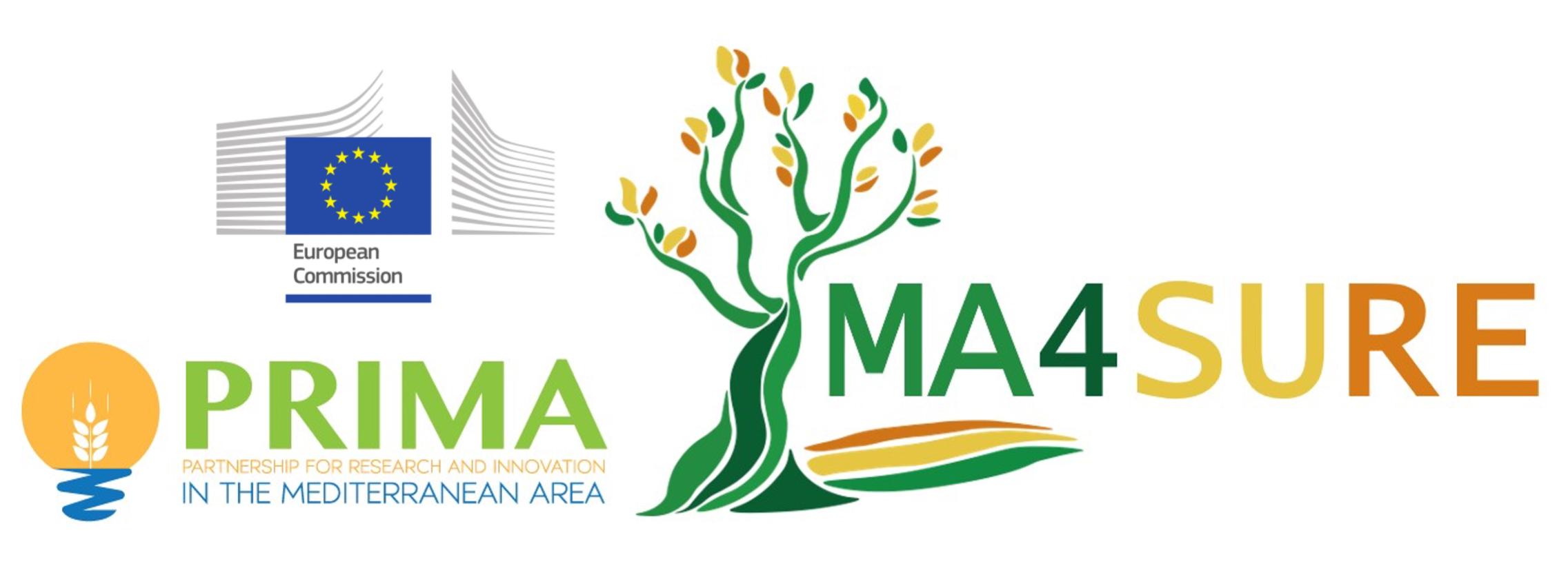
MA4SURE work packages approach
State-of-the-practice agriculture macroeconomic models fail to capture and integrate the biophysical flows driven by farming, livestock and forestry, which, in turn, impact landscape processes, ecosystem services, climate change mitigation and adaptation, and the overall resilience of agriculture. Therefore, MA4SURE aims to assess these impacts in an integrative fashion, by linking them to socioeconomic flows, as well as to the geographical and sociological realities, revealing the nexuses between different dimensions and the multiple scales at stake in Mediterranean agroecosystems.
To achieve this, MA4SURE adopts an inter-disciplinary approach that combines the fields of agronomy, genetics, agroecology, landscape ecology, bio-economics, sociology, geography, policy and communication. The work is organized in six work packages that aim to evaluate the capacity of agroforest and mixed farming systems to increase sustainable management, and the suitability and desirability of an agroecological transition in the Mediterranean region, by bringing in a more circular functioning of agroecosystems in response to climate change.
Administrative management and scientific coordination (WP1)
Description
This work package aims to ensure that MA4SURE achieves its objectives by coordinating the consortium, providing efficient administrative and scientific management, monitoring and quality control, securing links between work packages, case studies and living labs.
Sustainable agroforestry under climate change (WP2)
Description
The overall objective of this work package is to evaluate sustainable agroforestry systems under climate change. It is done by implementing an efficient cultivation system of annual cereals intercropped with legumes, olive trees and hazelnuts under good drought stress tolerance and using different soil tillage practices. This agroforestry system shall ensure soil structure and fertility conservation by reducing water input and increasing water capture and conservation. Irrigation will be managed with an automated drip irrigation system, a system with high efficiency, which can reduce water consumption. By the synergic use of these techniques, it is possible to reduce external inputs both in terms of water and fertilizers, and to improve agroecosystem sustainability by promoting a new farming system more economically viable.
Mixed farming systems under climate change (WP3)
Description
The overall objective of this work package is to increase and diversify the production and the productivity of farming systems and improve the performance of smallholder agricultural systems. The work package aims to develop best-practice agroforestry systems in the Al-Sharqiya region of Egypt to study different intercropping systems, as well as the effects of the tillage and cover crops and the effect on soil fertility and subsequently suggest best agroforestry models to be adopted by farmers. The purpose of these models is to reduced water use by monitoring irrigation, improving farming practices, and soil-water holding capacity. Another aim is to reduce farm wastes by reusing/recycling them, for example using it for mulching and weed control as well as calculating the cost to determine its economic benefit for the farmer. Together, this information is aimed to increasing farmer outcome through adopting cultivation plan of cash crops.
Socio-economic-ecological integrated analysis (WP4)
Description
The overall objective of this work package is to carry out a socio-economic-ecological integrated analysis (SIA) at a regional level of the three living labs of the project. This analysis will allow us to identify the ecological feasibility, technical and economic viability, and social equity of scaling up the agroforestry / mixed farming practices in a variety of Mediterranean agroecosystems. WP4 is based on biophysical and agroecological models interrelated through a nexus approach. Therefore, the SIA model assesses the impacts of agroecological management on biophysical flows, landscape functioning, biodiversity and ecosystem services, socioeconomic status of farmers practicing agroforestry/mixed farming for climate change mitigation and adaptation.
Policy analyses, social impact and road mapping (WP5)
Description
The overall objective of this work package is to develop policy guidance for decision-makers towards resilient, efficient, and sustainable agroecosystems. The specific objectives are: i) to assess the role of public policies in influencing farming systems and spatial dynamics and to identify the best practices in terms of management of land and water resources; and ii) to develop a methodology to strengthen the social and political dimensions of the living labs.
Integration, dissemination and technology transfer (WP6)
Description
The overall objective of this work package is to build and foster close links between science, policy, management and society. This work package works on the integration of data and information streams to
perform the general synthesis of the project, and syntheses key findings from WPs for dissemination purposes, provide protocols and Practical Abstracts of best-practices and recommendations for sustainable and facilitate outreach of project results to scientific community and general public, and finally to strengthen networking with other related projects.
Results
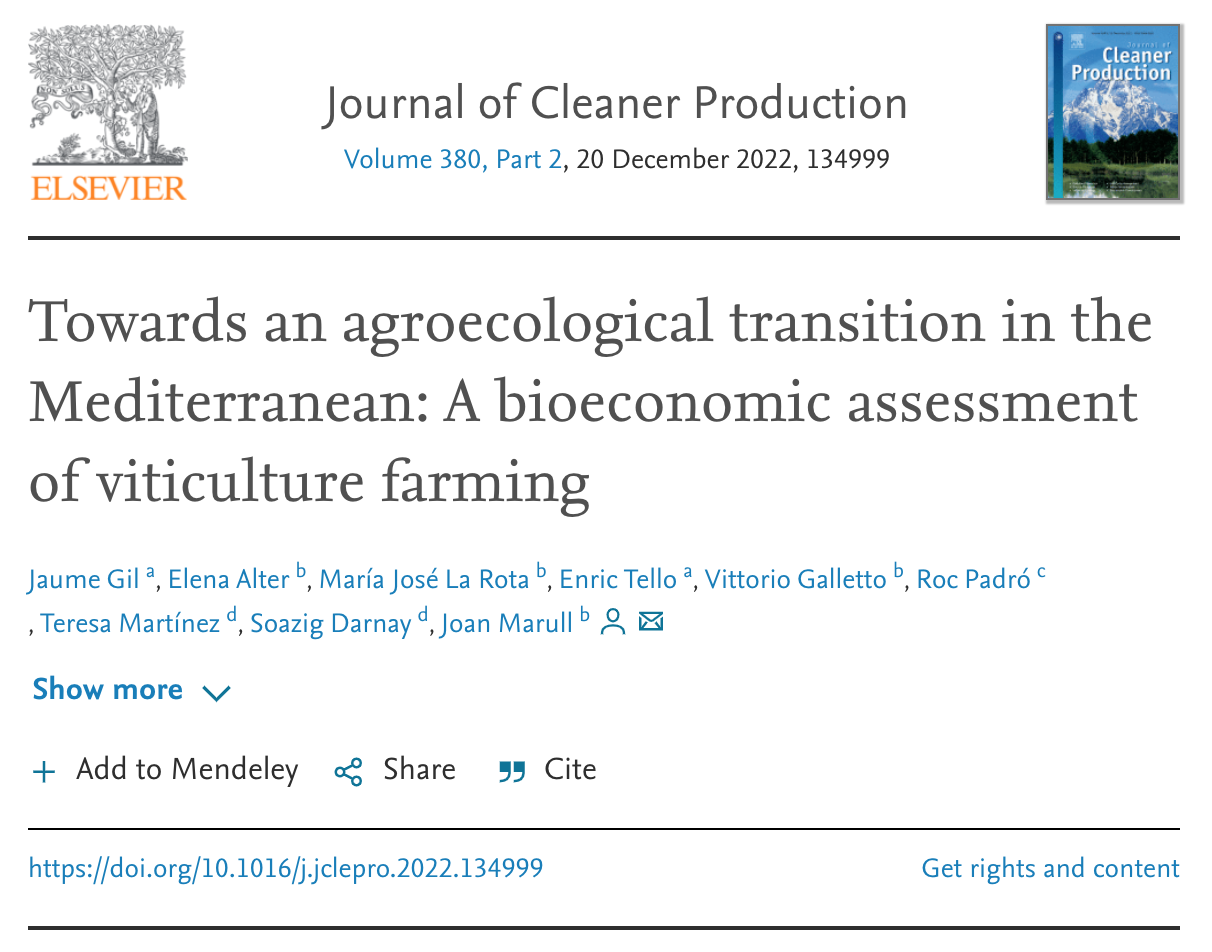
Towards an agroecological transition in the Mediterranean: A bioeconomic assessment of viticulture farming
Type: Paper
Abstract: Transformations in the agri-food system since the early 19th century have led to an unprecedented increase in food production. However, the structure of this system has generated many negative environmental and social impacts that threaten the sustainability at the local, regional and global scale. This situation entails the need for an agroecological transition that leads to an agri-food model that is aware of the planetary boundaries and guarantees the reproduction of human and all other forms of life. Agroecology is crucial for the Mediterranean, where the negative environmental and social impacts of industrial agriculture are particularly evident. The aim of this paper is to present a best practice viticulture farming that is in an advanced level of agroecological transition in the region. The results show that the energy efficiency of this agroecosystem is greater to conventional farms in the region, while generating similar financial returns but more equally distributed than the big agro-industrial companies in the sector. Based on this best practice case study, we provide several methodological and practical insights on the energy balance of the farm system, supplemented by data on the value-added distribution from wholesaler selling back to the industrial winemaking and vine-growing incomes, and the final financial returns of the company. The results highlight the need of multifactorial analyses that contribute to a systemic perspective on the synergic elements and leverage points for scaling-up the agroecological transition of Mediterranean viticulture.
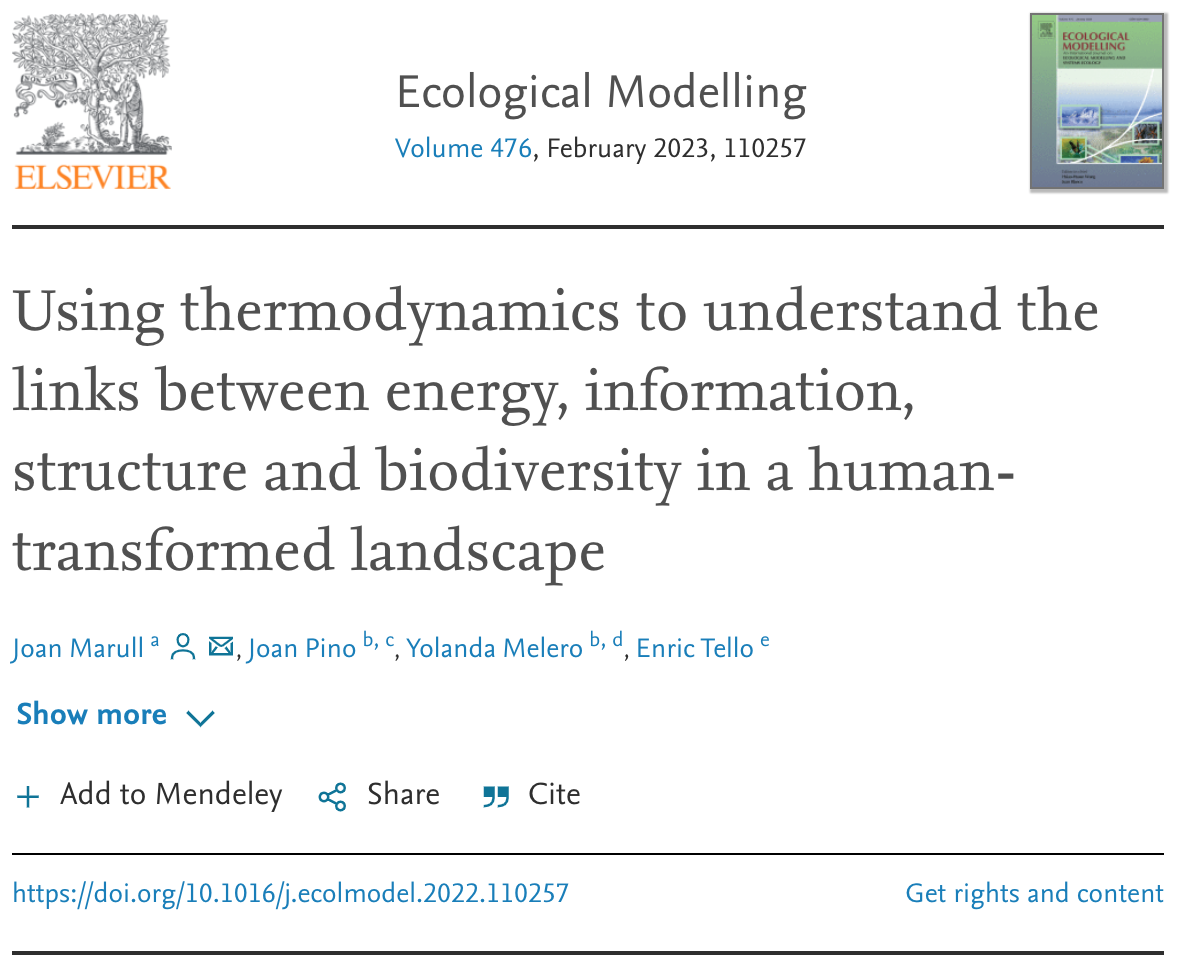
Using thermodynamics to understand the links between energy, information, structure and biodiversity in a human-transformed landscape
Type: Paper
Abstract: According to classical ecological theory, biodiversity at ecosystem scale can be viewed as the direct product of landscape complexity and information, and the inverse product of energy dissipation. The main difference between natural ecosystems and agroecosystems is the external energy driven by farmers. Hence, it could be argued that biodiversity in biocultural landscapes can be explained by an energy-information-structure model. We developed an Energy-Landscape Integrated Analysis (ELIA) to predict biodiversity levels in human-transformed landscapes. ELIA combines the energy-flow accounting in agricultural landscapes from abioeconomic point of view and landscape ecological metrics that assess the functional structure of the land cover. It uses indicators to assess the energy stored in internal loops (E) and the information incorporated into the energy network (I) to establish a correlation with the resulting patterns and processes in biocultural landscapes (L). We tested the model on biodiversity data using butterflies and birds. The results showed positive correlations between butterfly and bird species richness and ELIA, and, above all, between I and ELIA. This emphasizes how different strategies of agricultural management combined with nature conservation can be employed at certain optimal points in the relationship between the energy-information-structure of biocultural landscapes and the biodiversity present therein. ELIA modelling is the key to a new research agenda that will be very useful for designing more sustainable agroecosystems, metropolitan green infrastructures, and land-use policies, in line with the forthcoming Agroecology Transition planned by the European Commission and the Food and Agriculture Organization.
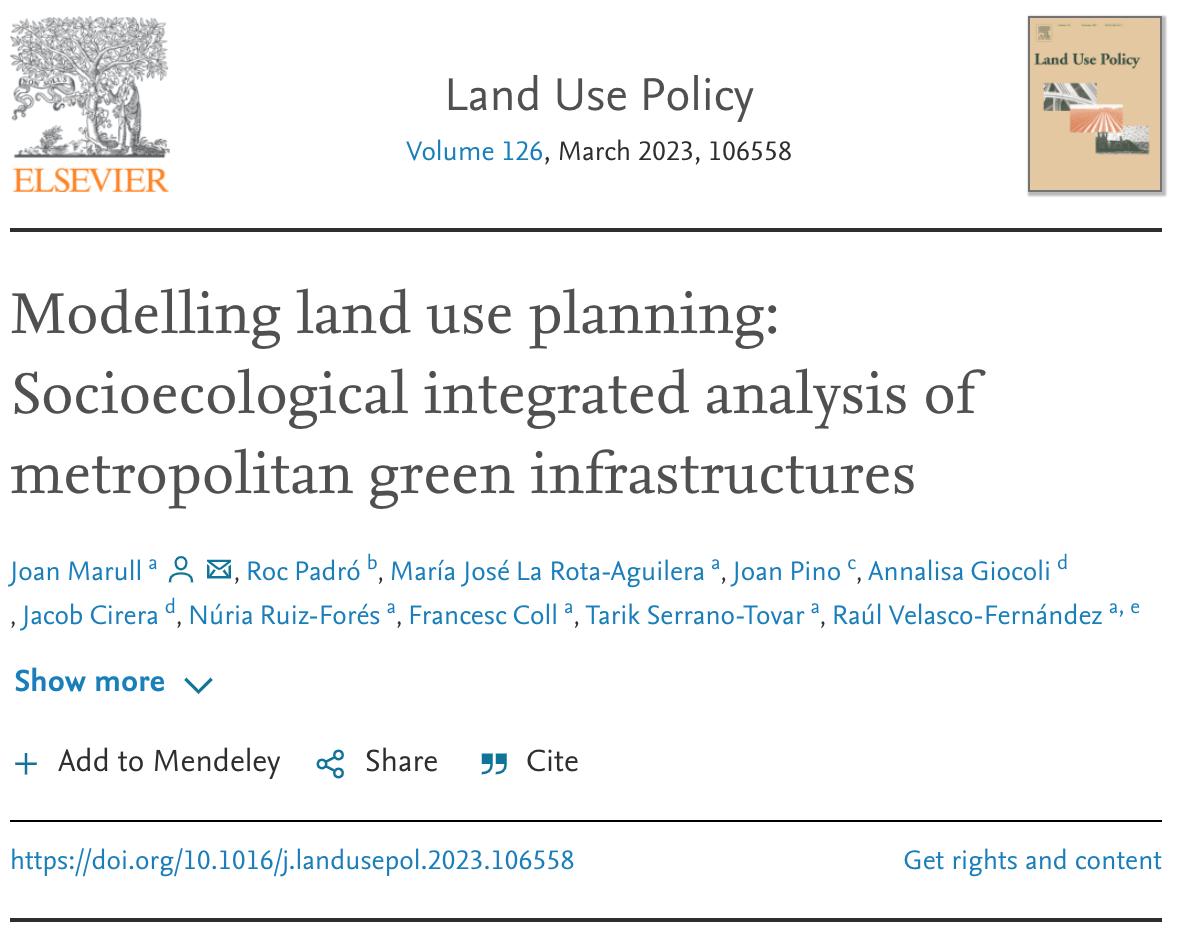
Modelling land use planning: Socioecological integrated analysis of metropolitan green infrastructures
Type: Paper
Abstract: Land use planning of global metropolis is essential to meet the socioecological challenges of the next decades. This paper aims to contribute to sustainable land use policies by proposing a socioecological integrated analysis of metropolitan green infrastructures, applying this landscape-metabolism model to the Urban Master Plan of the Barcelona Metropolitan Area. The paper assesses the multiple functions and services of the green infrastructure in four land use scenarios and two types of agricultural management. The results show that the trending scenario of applying the current land use planning would have a negative impact in the ecological functioning of the landscape, affecting biodiversity and the provision of ecosystem services to society. The results also show that certified organic farming is not enough to overcome some trends of industrial agriculture as low energy efficiency or greenhouse gas emissions. Finally, the results show different interactions between social metabolism and landscape ecology, as changes in the form of metabolism affect the functioning of the landscape, while changes in land cover specially affect resource use. Therefore, deeper changes are needed in land use policies that consider not only land covers, as has traditionally been done, but also metabolic flows to promote agroecological transitions towards more sustainable metropolitan green infrastructures under climate change scenarios.
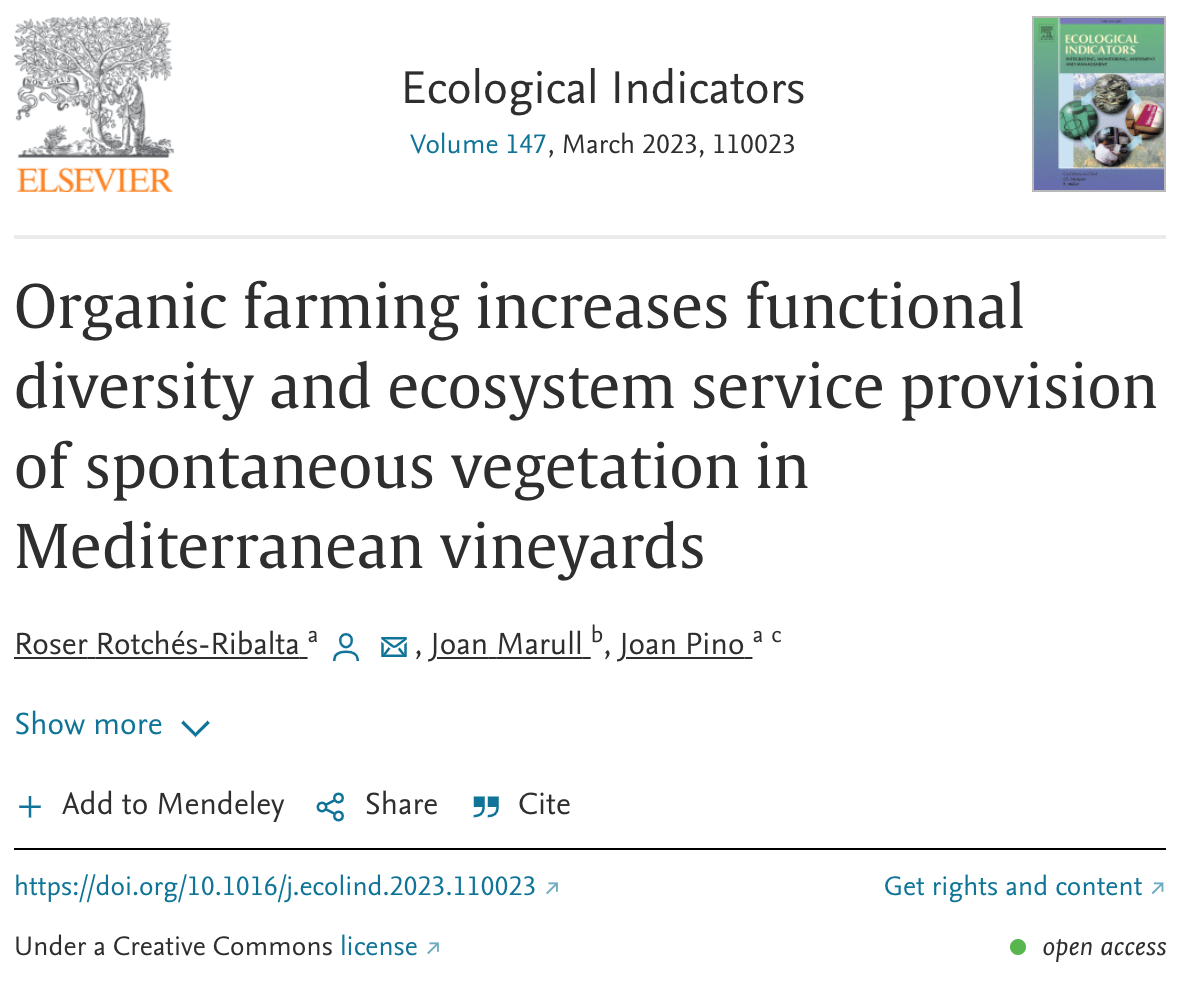
Organic farming increases functional diversity and ecosystem service provision of spontaneous vegetation in Mediterranean vineyards
Type: Paper
Abstract: Spontaneous plant species in agricultural systems (i.e., weeds) are bound to become key ecological indicators of agroecosystem resilience as they show high sensitivity to management, while they ensure the assembly of multiple ecological functions. Here we used the response-effect functional framework on spontaneous plant species growing in both organic and conventional vineyards, to assess whether their plant communities respond to contrasted farming systems and to soil conditions according to its competitive response and the provisioning of pollination services. The results show that the spontaneous plant communities and its functions better reflected the effects of management -when considering the dichotomy organic-conventional farming- rather than soil conditions. Organic management in vineyards promoted higher plant species richness, with varied competitive response strategies to deal with different environmental conditions and management disturbances. Organic vineyards held more diverse and resilient plant communities for the provisioning of pollinator services than the conventional ones, which is expected to enhance pollinator communities with diverse feeding guilds. In contrast, conventional farming systems selected anemophilous plants or those with flower attributes related to generalist pollinators. Such results highlight the significance of organic farming for the sustainment of the local accompanying plant diversity but also for the provisioning of ecosystem services in these agricultural landscapes. Besides, the study reinforces the applicability of the response-effect framework to identify the effects of vineyard management on the spontaneous plant communities and its potential impacts on the pollinator communities.
